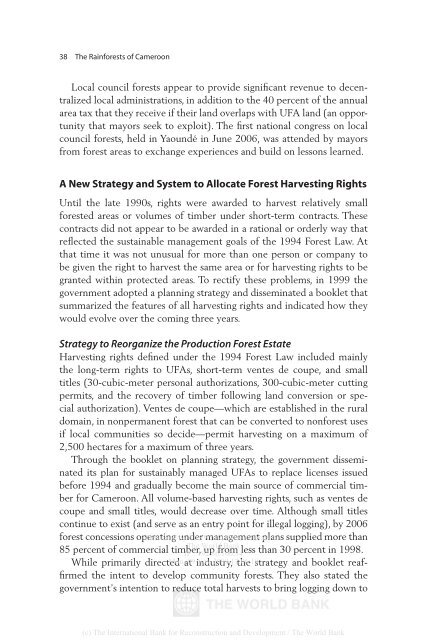The Rainforests of Cameroon - PROFOR
The Rainforests of Cameroon - PROFOR
The Rainforests of Cameroon - PROFOR
- No tags were found...
Create successful ePaper yourself
Turn your PDF publications into a flip-book with our unique Google optimized e-Paper software.
38 <strong>The</strong> <strong>Rainforests</strong> <strong>of</strong> <strong>Cameroon</strong>Local council forests appear to provide significant revenue to decentralizedlocal administrations, in addition to the 40 percent <strong>of</strong> the annualarea tax that they receive if their land overlaps with UFA land (an opportunitythat mayors seek to exploit). <strong>The</strong> first national congress on localcouncil forests, held in Yaoundé in June 2006, was attended by mayorsfrom forest areas to exchange experiences and build on lessons learned.A New Strategy and System to Allocate Forest Harvesting RightsUntil the late 1990s, rights were awarded to harvest relatively smallforested areas or volumes <strong>of</strong> timber under short-term contracts. <strong>The</strong>secontracts did not appear to be awarded in a rational or orderly way thatreflected the sustainable management goals <strong>of</strong> the 1994 Forest Law. Atthat time it was not unusual for more than one person or company tobe given the right to harvest the same area or for harvesting rights to begranted within protected areas. To rectify these problems, in 1999 thegovernment adopted a planning strategy and disseminated a booklet thatsummarized the features <strong>of</strong> all harvesting rights and indicated how theywould evolve over the coming three years.Strategy to Reorganize the Production Forest EstateHarvesting rights defined under the 1994 Forest Law included mainlythe long-term rights to UFAs, short-term ventes de coupe, and smalltitles (30-cubic-meter personal authorizations, 300-cubic-meter cuttingpermits, and the recovery <strong>of</strong> timber following land conversion or specialauthorization). Ventes de coupe—which are established in the ruraldomain, in nonpermanent forest that can be converted to nonforest usesif local communities so decide—permit harvesting on a maximum <strong>of</strong>2,500 hectares for a maximum <strong>of</strong> three years.Through the booklet on planning strategy, the government disseminatedits plan for sustainably managed UFAs to replace licenses issuedbefore 1994 and gradually become the main source <strong>of</strong> commercial timberfor <strong>Cameroon</strong>. All volume-based harvesting rights, such as ventes decoupe and small titles, would decrease over time. Although small titlescontinue to exist (and serve as an entry point for illegal logging), by 2006forest concessions operating Delivered under by <strong>The</strong> World management Bank e-library plans to: supplied more than<strong>The</strong> World Bank85 percent <strong>of</strong> commercial timber, IP : 192.86.100.34 up from less than 30 percent in 1998.While primarily directed Mon, at 09 industry, Nov 2009 17:06:18 the strategy and booklet reaffirmedthe intent to develop community forests. <strong>The</strong>y also stated thegovernment’s intention to reduce total harvests to bring logging down to(c) <strong>The</strong> International Bank for Reconstruction and Development / <strong>The</strong> World Bank
















